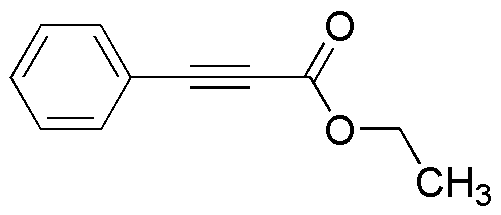Ethyl phenylpropiolate is widely utilized in research focused on:
- Organic Synthesis: This compound serves as a valuable intermediate in the synthesis of various organic molecules, including pharmaceuticals and agrochemicals, due to its unique reactivity.
- Flavors and Fragrances: It is used in the formulation of flavoring agents and fragrances, providing a sweet, fruity aroma that enhances consumer products in the food and cosmetic industries.
- Polymer Chemistry: Ethyl phenylpropiolate is employed in the production of specialty polymers, contributing to materials with enhanced properties such as flexibility and durability.
- Biological Research: Researchers utilize this compound in studies related to cell signaling and enzyme activity, helping to uncover mechanisms in biochemistry and molecular biology.
- Material Science: Its application in the development of advanced materials, such as coatings and adhesives, offers improved performance characteristics compared to traditional compounds.
General Information
Properties
Safety and Regulations
Applications
Ethyl phenylpropiolate is widely utilized in research focused on:
- Organic Synthesis: This compound serves as a valuable intermediate in the synthesis of various organic molecules, including pharmaceuticals and agrochemicals, due to its unique reactivity.
- Flavors and Fragrances: It is used in the formulation of flavoring agents and fragrances, providing a sweet, fruity aroma that enhances consumer products in the food and cosmetic industries.
- Polymer Chemistry: Ethyl phenylpropiolate is employed in the production of specialty polymers, contributing to materials with enhanced properties such as flexibility and durability.
- Biological Research: Researchers utilize this compound in studies related to cell signaling and enzyme activity, helping to uncover mechanisms in biochemistry and molecular biology.
- Material Science: Its application in the development of advanced materials, such as coatings and adhesives, offers improved performance characteristics compared to traditional compounds.
Documents
Safety Data Sheets (SDS)
The SDS provides comprehensive safety information on handling, storage, and disposal of the product.
Product Specification (PS)
The PS provides a comprehensive breakdown of the product’s properties, including chemical composition, physical state, purity, and storage requirements. It also details acceptable quality ranges and the product's intended applications.
Certificates of Analysis (COA)
Search for Certificates of Analysis (COA) by entering the products Lot Number. Lot and Batch Numbers can be found on a product’s label following the words ‘Lot’ or ‘Batch’.
*Catalog Number
*Lot Number
Certificates Of Origin (COO)
This COO confirms the country where the product was manufactured, and also details the materials and components used in it and whether it is derived from natural, synthetic, or other specific sources. This certificate may be required for customs, trade, and regulatory compliance.
*Catalog Number
*Lot Number
Safety Data Sheets (SDS)
The SDS provides comprehensive safety information on handling, storage, and disposal of the product.
DownloadProduct Specification (PS)
The PS provides a comprehensive breakdown of the product’s properties, including chemical composition, physical state, purity, and storage requirements. It also details acceptable quality ranges and the product's intended applications.
DownloadCertificates of Analysis (COA)
Search for Certificates of Analysis (COA) by entering the products Lot Number. Lot and Batch Numbers can be found on a product’s label following the words ‘Lot’ or ‘Batch’.
*Catalog Number
*Lot Number
Certificates Of Origin (COO)
This COO confirms the country where the product was manufactured, and also details the materials and components used in it and whether it is derived from natural, synthetic, or other specific sources. This certificate may be required for customs, trade, and regulatory compliance.

